The boys are visiting their grandmother this weekend… which gives me lots of time to work on the house. I was able to mow the grass as well as work on Ben’s room.
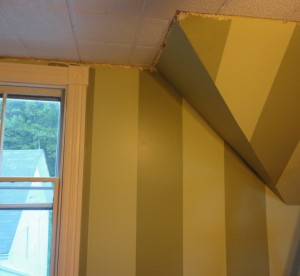
Last weekend I put together the crown molding pieces for the edge of the ceiling where it meets the sloped wall. Crown molding is designed for a 90 degree angle (normal vertical wall), but the room has two sections of the wall where it isn’t vertical. It wouldn’t be a problem if I had put drywall on the ceiling. However, I did a tin ceiling (well, aluminum) and that requires crown molding to cover the edge of the metal ceiling. This morning I was able to prime and paint the crown molding, and this evening I was able to install the two pieces on the sloped wall. The rest I will cope and install tomorrow. Excuse the color of the first image, the inside lights make the image a bit yellowish.
To make the crown molding fit, I cut a piece of wood to fit in the gap between the molding and the sloped wall. I glued the wood piece to the molding and then attached it as a single piece of trim.
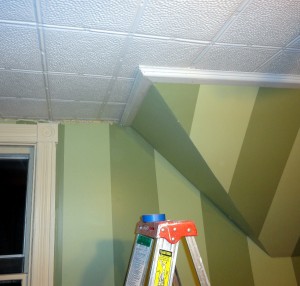
I also painted the trim around the door to the closet. I don’t have any baseboard trim up yet, so painting one door at a time make sense. I’ll just have to touch up where I install the baseboard trim. The process was pretty easy. I taped around the trim. I then ran a bead of caulk around the edge of the trim (to make up for unevenness in the wall), smoothing the caulk with my finger. I then removed the tape before the caulk cured. After the caulk cured for two hours, I re-taped around the trim and primed and painted the trim. The result is a very clean joint between the trim and the wall. The first picture is of the trim as installed.
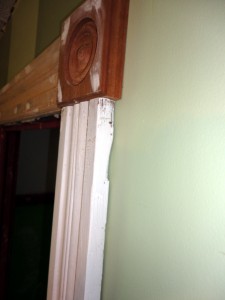
The trim pieces are original. Some of the pieces were damaged when they were pulled off the wall when I started renovating the room. I made the rosettes (a bunch of the originals broke when I removed them).
A suggestion to anyone removing and reinstalling trim:
In my last house, I made the mistake of hammering the nails from the back of the trim, then pulling them out from the from. That caused the large holes where the finish nails pushed chips of wood out. For this project I pulled the nails out from the back. Trim is installed with finish nails, and they are simple to pull out from the back. That leaves the front of the trim looking clean. I purchased a special pair of pliers for this purpose (crazy that they make a tool for specifically pulling the nails through the trim from the back).
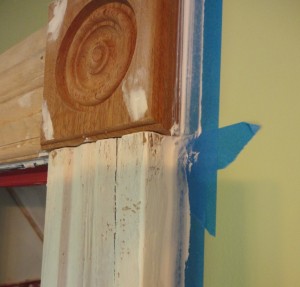
Making the Rosettes
I purchased a drill bit to make the rosettes. I had searched at Home Depot and found trim rosettes, but they were just a little too small for the trim I had. So I had to make them. I milled some scrap sapele to 1″ thickness and then cut squares out the appropriate size. I set up a fence on the drill press and drilled out enough rosettes for the room (and a spare or two). Of course it is a shame to prime and paint a nice wood like sapele… but it was scrap so it is cheaper than getting pine at the box store.
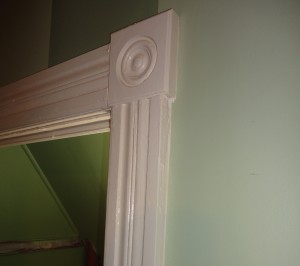
When I was waiting for painting projects to dry, I started my next workshop project. I milled most of the white oak needed for a sitting bench that will go out by the fire pit (what is there now looks terrible). The big question is do I make it a quick project (and use pocket hole screws to put together), or do I take the time and make it with mortise and tenon joints. I’m actually leaning towards mortise and tenon joints – I’ve been avoiding traditional joinery for the past few projects.

lovely 🙂